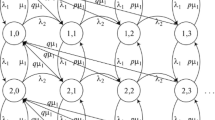Abstract
We study a single server queue with two different arriving streams, a tagged arrival process and a background arrival process. The tagged traffic is assumed to be an interrupted Poisson process (IPP) and the background traffic is Poisson. The service time is exponentially distributed, and customers are served in a FIFO manner. We obtain numerically the probability density function of the inter-departure time of the IPP tagged arrival process, from which we calculate its jitter, defined as a percentile of the inter-departure time. Numerical results of the 95th percentile and the squared coefficient of variation of the tagged inter-departure time are given as a function of the arrival rate of the background traffic.









Similar content being viewed by others
References
Benkert K, Fischer R (2007) An efficient implementation of the Thomas-algorithm for block penta-diagonal systems on vector computers. Lect Notes Comput Sci 4487:144–151
Bitran GR, Dasu S (1993) Approximating nonrenewal processes by Markov chains: use of super-Erlang (SE) chains. Oper Res 41(5):903–923
Dasu S (1998) Class dependent departure process from multiclass phase queues: exact and approximate analyses. Eur J Oper Res 108(2):379–404
Grinstead CM, Snell JL (n.d.) Introduction to probability, 2nd edn. http://www.dartmouth.edu/~chance/teaching_aids/books_articles/probability_book/book.html. Accessed 12 Feb 2012.
Kumaran J, Mitchell K, van de Liefvoort A (2005) An analytic model of correlations induced in a packet stream by background traffic in IP access networks. Proceedings of the 19th international teletraffic congress. Beijing, pp 687–696
Mitchell K, van de Liefvoort A, Place J (2000) Second-order statistics of an isolated departure stream from a shared buffer with correlated sources. Proceedings of the 8th international conference on telecommunication systems, modeling and analysis. Nashville, pp 565–574
Sohraby K, Privalov A (1999) End-to-end jitter analysis in networks of periodic flows. Proceedings of IEEE INFOCOM ’99. 18th Annual joint conference of the IEEE computer and communications societies, 2. New York, pp 575–583
Stanford D, Fischer W (1989) The interdeparture-time distribution for each class in the \(\Sigma _iM_i/G_i/1\) queue. Queueing Syst 4(3):179–191
Stewart WJ (2009) Probability, Markov chains, queues, and simulation. Princeton University Press, Princeton
Ward RC (1977) Numerical computation of the matrix exponential with accuracy estimate. SIAM J Numer Anal 14(4):600–610
Whitt W (1983) The queueing network analyzer. Bell Syst Tech J 62(9):2779–2815
(2011) Network performance objectives for IP-based services, ITU-T Standard Y.1541. http://www.itu.int/rec/T-REC-Y.1541-201112-I/en. Accessed 14 March 2013
(2012) Reporting IP Network performance metrics: different points of view, IETF RFC 6703. http://tools.ietf.org/html/rfc6703. Accessed 14 March 2013
Author information
Authors and Affiliations
Corresponding author
Rights and permissions
About this article
Cite this article
Geleji, G., Perros, H. Jitter analysis of an IPP tagged traffic stream in an {IPP,M}/M/1 queue. Ann. Telecommun. 69, 283–294 (2014). https://doi.org/10.1007/s12243-013-0362-y
Received:
Accepted:
Published:
Issue Date:
DOI: https://doi.org/10.1007/s12243-013-0362-y




